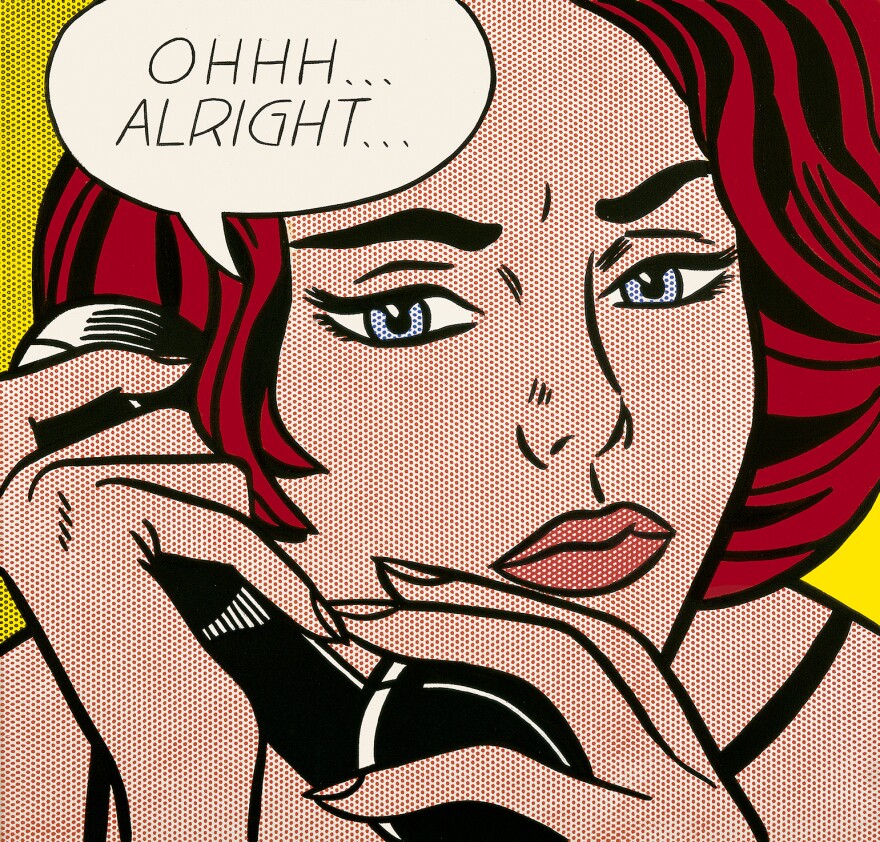Whaam! Varoom! R-rrring-g! The canvases of painter Roy Lichtenstein look as if they're lifted from the pages of comic books. Comics were a big inspiration for this pop artist, who was rich and famous when died in 1997 at age 73. But at a major Lichtenstein retrospective at Washington's National Gallery of Art, you can see that the artist found inspiration beyond comic books; he also paid his respects to the masters — Picasso, Monet and more.
Lichtenstein's 1960s works were comic-inspired — they're angsty frames, often featuring ladies in distress. In one iconic image, a beautiful, fraught woman with a furrowed brow grasps a telephone in both hands as she says "Ohh ... Alright ..." You just know she's talking to a fellow.
"What I like about it is the way she's holding the phone," says National Gallery curator Harry Cooper. "She's caressing the phone, and I think in a way she would rather have a relationship with the receiver than with whoever is on the other end of the line."

Who knows what he's saying to her and what she's reluctantly agreeing to. Lichtenstein lets us imagine the back story — and what might happen next. Cooper says the artist "really looked hard for these comics that had a kind of crux of the story in them."
It's interesting that he managed to evoke such strong emotions using such a cold, mechanical process of dots — he was really painting digital pixels before there were pixels. Lichtenstein didn't paint each and every dot by hand. Instead, he used various kinds of stencils with perforated dot patterns. He'd brush his paint across the top of the stencil, and the colors dropped through, as perfect circles. In doing so, he was elevating commercial images from comics, and ads into art.
In the 1960s, young American artists were looking for ways to make their marks. Andy Warhol did it with soup cans. Roy Lichtenstein did it with dots. Inventing pop art, comic-book frames were his starting point — but he wasn't making exact reproductions.
"He's always making these alterations," Cooper says. "He did it because he felt these things could be improved ... they weren't quite art, but he could make them art."

By changing a hue, widening a line, expanding the dots, Lichtenstein changed "tiny things that would help make an iconic image," Cooper says. "An image that would stand up, would last on the wall, last in our memories."
You can always tell a Lichtenstein — his work speaks in a vocabulary of dots. And he makes you laugh. (Another fraught woman, this one drowning, thinks: "I don't care! I'd rather sink — than call Brad for help!") The fraughts are from a series on romance.
In another series, Brushstrokes, he addresses that basic element of art. In 1993, he told WHYY's Fresh Air that he was painting the idea of a brush stroke. The point wasn't to make people think it's a real brush stroke. "You think it's a picture of a brush stroke," Lichtenstein said. "And that's a kind of absurd thing to do. It has that built-in absurdity, and that's the reason I like it."

Dorothy Lichtenstein, the painter's widow, says that with his dots her husband moved beyond the post-World War II abstract expressionists — Pollock with his drips, de Kooning with his brush sweeps — but he kept the past in his rearview mirror.
"Certainly his brush stroke paintings were an ode in some way to abstract expressionism," says Dorothy Lichtenstein. "He thought ... you could look at the history of art as the history of brush strokes as well."
Lichtenstein had some trouble making brush strokes, but he used his dots to reproduce some of his greatest brushy predecessors. He was inspired by Monet's Rouen Cathedral series of the late 1890s, and in 1969, turned his pale, dotty cathedrals into glowing shimmers.
Dorothy Lichtenstein says her husband went to museums in search of the masters. "It was actually great going to a museum with Roy," she says. "Everything was grist for his mind. He was always looking at paintings and how he might be able to transform them."

Picasso was his hero, says curator Harry Cooper. "Matisse was right up there, but it was really Picasso he attacked first."
"Attacked," Cooper says — not "tackled." Lichtenstein was paying his respects to Picasso and Mondrian and Monet and others, but it wasn't just an homage.
"It's also bringing these artists down to the level of dots and comic vocabulary," says Cooper. "I think artists are always very anxious about their predecessors — the anxiety of influence. And so what he said about Picasso was that he realized he could make it his own, and that felt good."
Cooper says Lichtenstein made a real impact. "We can't go anywhere without seeing pop art," he says. He helped bring pop art into design and larger culture, and showed that it wasn't "just a gimmick, just a joke."
Maybe. But you'll still get some good laughs at the National Gallery's Lichtenstein retrospective until mid-January. The show will travel to London and Paris. (If travel isn't on your horizon, there's a hefty catalog to peruse.)
Copyright 2021 NPR. To see more, visit https://www.npr.org.



